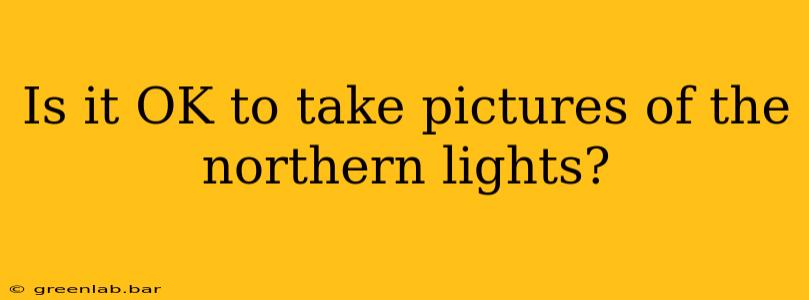The short answer is a resounding yes! Taking pictures of the aurora borealis is not only okay, it's actively encouraged. Witnessing this breathtaking natural phenomenon is a once-in-a-lifetime experience for many, and capturing its ethereal beauty through photography allows you to relive the magic and share it with others. However, successfully photographing the aurora requires more than just pointing your camera at the sky. This guide will delve into the best practices for capturing stunning aurora photos, addressing common questions and challenges along the way.
Understanding the Challenges of Aurora Photography
Before we jump into techniques, let's acknowledge the inherent difficulties:
- Low Light Conditions: The aurora often appears in very dark environments, demanding a high ISO and long exposure times. This can lead to noise and blurriness.
- Constant Movement: The aurora is dynamic, constantly shifting and changing in brightness and shape. Capturing its fleeting beauty requires quick adjustments and a bit of luck.
- Predictability: While you can increase your chances by checking aurora forecasts, the aurora's behavior remains unpredictable. Patience is key.
Essential Gear for Aurora Photography
While you can technically capture something with your smartphone, dedicated photography equipment significantly enhances your chances of capturing truly breathtaking images.
1. Camera Body:
- DSLR or Mirrorless: These offer greater control over settings than smartphones. A full-frame sensor provides better low-light performance.
2. Lens:
- Wide-Angle Lens: Crucial for capturing the expansive nature of the aurora. A focal length of 14-24mm (full-frame equivalent) is ideal. Faster apertures (e.g., f/2.8) are beneficial in low light.
3. Tripod:
- Sturdy Tripod: Absolutely essential for long exposures. A robust tripod ensures stability and prevents blurry images.
4. Remote Shutter Release:
- Wired or Wireless: Minimizes camera shake during long exposures, leading to sharper images.
5. Extra Batteries & Memory Cards:
- Prepare for the cold: Cold temperatures significantly reduce battery life. Bring plenty of spares. Similarly, ensure you have ample memory card space.
Mastering the Camera Settings for Aurora Photography
The key to stunning aurora photos lies in mastering your camera settings. Here's a starting point:
1. Manual Mode (M):
- Take complete control of your camera's settings.
2. ISO:
- Start with a high ISO (e.g., 800-3200), but be mindful of noise. Adjust based on the aurora's brightness and your camera's capabilities.
3. Aperture:
- Set your aperture as wide as possible (e.g., f/2.8 or f/4). This maximizes light intake.
4. Shutter Speed:
- This will vary depending on the aurora's brightness and movement. Start with 10-30 seconds and adjust as needed. Longer exposures capture more light but risk blurring if the aurora is rapidly changing.
5. Focus:
- Manually focus your lens to infinity (∞). Use live view to fine-tune.
Post-Processing Your Aurora Photos
Even with perfect in-camera settings, post-processing is often necessary to enhance your aurora photos. Software like Adobe Lightroom or Photoshop can help:
- Noise Reduction: Minimize noise introduced by high ISO settings.
- Brightness and Contrast Adjustment: Enhance the visibility of the aurora.
- Color Correction: Adjust the color balance for a more natural or dramatic look.
Beyond the Technicalities: Finding the Perfect Aurora Location and Timing
- Light Pollution: Escape city lights; find a dark location away from artificial illumination.
- Aurora Forecasts: Use websites and apps to check aurora forecasts for your location.
- Weather Conditions: Clear skies are essential. Cloud cover will obscure the aurora.
- Patience: Aurora photography requires patience. The aurora's appearance is unpredictable.
Capturing the magic of the northern lights through photography is a rewarding experience. While challenging, mastering the techniques and utilizing the right equipment will vastly increase your chances of capturing truly memorable images of this breathtaking celestial display. Remember, practice makes perfect, so don't be discouraged if your first few attempts aren't perfect. Keep experimenting, and you'll soon be capturing stunning aurora photographs.

